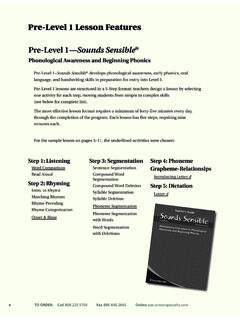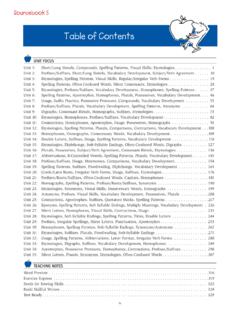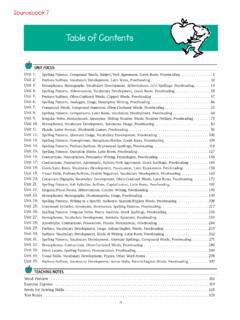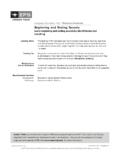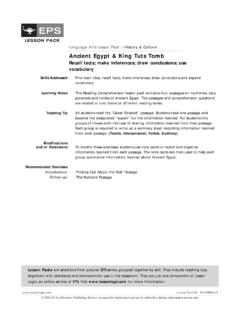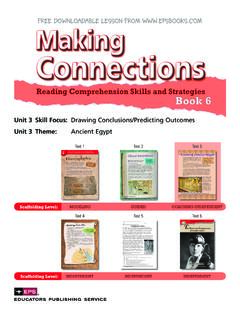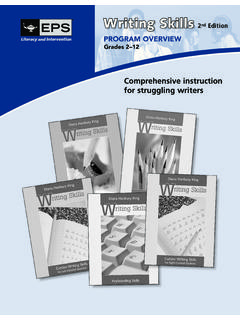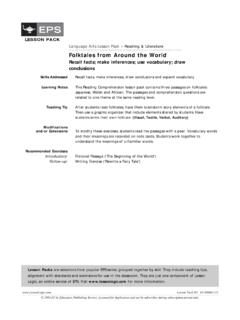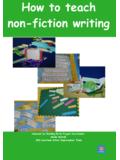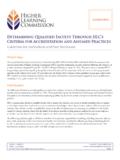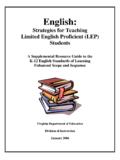Transcription of Activating Comprehension: Non-Fiction in the Classroom
1 EDUCATORS PUBLISHING SERVICEA ctivating comprehension : Non-Fiction in the Classroom is the reason for reading. According to Put Reading First: The Research Blocks for Teaching Children to Read, good readers are purposeful and active, but it is often difficult to earn and maintain a student s interest in a text. One of the best ways to engage students in reading and learning is through nonfiction. Much research has been done on why and how students can best comprehend a text, but less has been said about what kinds of texts can best aid the development of comprehension skills. Besides the usual trade book, basal reader, or magazine article, there are many other texts on many interesting topics, an endless variety of people, places, and things to read about. Nonfiction can help students learn to read purposefully and actively, to develop strategies, to interact directly with a text while exploring new people and places, investigating new ideas about the world around , I had parents who were always telling me interesting stories about people, places, and historical events.
2 Unfortunately, in our hectic world parents don t always have time to tell stories. As teachers, we can make these stories of positive role models and significant events a dynamic part of the curriculum. When I started teaching reading comprehension , many of my students said they wished there were more books about women who had lived long ago. Then my students told me that they would like some stories about men, too, and about people living right now who had made a difference in the world. When I first started planning my biography series, I thought all my subjects would be deceased. After all it s easier for the author; no one will pop up and question you, and there will be no unpleasant surprises. But after talking to a number of children I decided that half the subjects in my books should be living. To a second, third, or even fourth grader, fifty years might as well be several hundred.
3 And when asked, most children will tell you that they much prefer reading about something that is happening now, not something that happened long ago. I also found that once students become interested in reading about living people, they are more willing to read about an important person of the past. I feel the same way about places and events. Get your students interested in current events or neighborhood or city issues, and then you will see that historical places and events gain new significance, a new life. So how can you use nonfiction to develop comprehension skills? The vitally important first step is for you to show and share your enthusiasm not only for the person, place, or event you re going to read about, but also for the activity of reading itself. Research shows that motivated teachers motivate children. Modeling enthusiasm and appreciation for reading is ever important in teaching children to enjoy reading and developing students literacy horizons.
4 You need to be a cheerleader for your next step is pre-reading. Before your students begin reading a text, introduce any challenging vocabulary in advance. The National Reading Panel (2000) reports that the complex process of reading comprehension can not be understood without a clear description of the role that vocabulary development and vocabulary instruction play in the understanding of what has been read. We all know from our own experience that sometimes one can understand the meaning of a word through its context, but often one cannot, especially if it is a content-area word in a content area with which one is not familiar. Before your class reads a story about women workers of World War II, you should pre-read the text and record the challenging words: discrimination, distract, welding, riveter, and foundry. Write them on the board and pronounce them clearly.
5 Then ask if anyone knows what they mean. If no one does, write the definition. In the Claims to Fame and Einstein s Who, What, and Where series, vocabulary words and definitions follow the passage. It is helpful to model these words in a sentence or have students create sentences using the new words. The larger the reader s vocabulary, the easier it is to fully understand a text (NRP, 2000). In order to help develop automaticity, I like to create personal word boxes, small file boxes of word cards, for my students. Students give the definition of the word on the card and use the word in a sentence five times in a row. If Activating Comprehension: Non-Fiction in the Classroomby Carol Einsteinthe student can do this correctly, I put a checkmark on the card. When the student gets five checkmarks in a row, I say that the word is automatic, and it s placed at the back of the file box in an automatic section to be reviewed later on.
6 My students are very proud of their boxes and many of them don t want to discard their automatic words. They save them from year to year as they become more and more fluent and better able to comprehend and appreciate what they read. Teachers need to make students active participants in the learning process right from the beginning. The most effective way is by personalizing the assignment, and one of the most effective methods for achieving this, as reporting in Reading First, is by engaging the students prior knowledge. The K-W-L model developed by Donna Ogle is an excellent strategy to use when reading nonfiction texts. This three-step process asks the students: What do you know? What do you want to know? What did you learn?Before students read a story, ask them what they know about the subject. If you are reading about Jerry Yang, the founder of Yahoo!, ask your students what they know about searching the Internet.
7 Next, ask them what they would like to know about it. After you have read the story, ask them to recall what they have just learned. These are crucial exercises to help engage students in the subject matter, and modeling is extremely important in K-W-L. Think aloud so your students can listen to your exact thinking process. Provide questions for the students to consider. In Claims to Fame and Einstein s Who, What, and Where, I have provided some model questions for students to ask themselves before they even begin reading. Before students read the story about women during World War II, I ask What have you done to help your community or your country? Before students read about the transcontinental railroad, I ask Why is it important for a country to have a good transportation system? Before they read a passage about the battle to end segregation, I ask When you see something unfair happening, what do you do?
8 Activating prior knowledge of the subject not only makes students think about what they are about to read, but also helps teachers understand and appreciate what each child brings to the reading experience. You can use the K-W-L strategy before, during, and after reading. You might want to ask some children to read their answers aloud. Demonstrate how you would answer such questions and verbalize your thought processes. Once your students have learned this strategy through modeling and practice, you can have them work in small groups, in pairs, or individually, and apply it to all kinds of texts. Remember that text comprehension is both purposeful and active. With high-interest nonfiction texts and strategies such as K-W-L, we give students a purpose for reading and learning. We also must encourage our students to be active readers in order to achieve their purpose, to get the very most from a text, and we can do this by teaching them specific strategies proven to increase comprehension (Armbruster et al.)
9 , 2000; Snow, 2000). The National Reading Panel (2000) outlines the most important of these scientifically-proven strategies, including: comprehension monitoring summarizing question answering question generating Monitoring one s own comprehension is a difficult task because it involves metacognition, or thinking about one s thought process. This strategy involves all the stages of reading, from thinking about what you already know about the subject, to adjusting your reading speed of the text, to fixing-up any problems that you encounter as you try to understand what you have read. One monitoring approach that has worked well with my students is coding. Encourage students to mark-up their texts: put a check next to parts they find interesting and a question mark next to something they don t understand. Students can put a star beside important ideas and write in the margin about why the ideas are important.
10 Modeling is a very important step in teaching the skill of active reading. I suggest you read aloud from a transparency text and think-aloud as your students follow in their books. As you read, model how to monitor your comprehension and interact with the text by coding it. Another proven strategy is summarizing. Encourage students to pause after they are through reading to think about what they have just read. Ask them to retell the story. 2 Activating comprehension : Non-Fiction in the comprehension : Non-Fiction in the Classroom they have trouble recalling what they read, they should reread the story again, this time more slowly and actively, monitoring their comprehension along the way. If students have difficultly recalling the entire passage, have them pause mid-text (or after every paragraph if the student is still struggling) and have them summarize the text up to that point.
